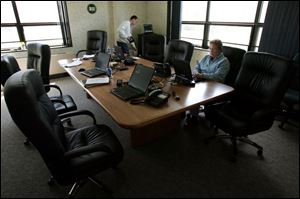
High-tech crisis center rankles HQ at ODOT
4/15/2005
Hiram Crabtree, ODOT network administrator, and Kelli Burkhardt, business administrator, work in the dual-use conference room and emergency operation center at an $8,800 table.
BOWLING GREEN - Weeks after completing an electronics-laden crisis-control center, local Ohio Department of Transportation officials now are contending with a problem the center can't handle: Angry bosses.
ODOT's headquarters in Columbus is investigating why the Bowling Green-based District 2 office spent $108,000 to refurbish an old conference room into an Emergency Operations Center.
ODOT Chief of Staff Andrew Gall said district offices were told to build such centers, but keep them to a "bare minimum of functionality."
"There was a degree of expenditure that we had expected," Mr. Gall said yesterday. "It's certainly beyond what we expected."
While not arguing with his bosses' assessments, District 2's director, Todd Audet, said he believed he was following their intent when he authorized the creation of what's considered the best-outfitted center of any of ODOT's 12 districts - complete with $36,000 in audio-visual equipment.
"We made every effort to cut back where we could, to make it reasonable where we could," Mr. Audet said.
Prompted by communication problems from the 2003 blackout, ODOT asked the districts last fall to create centers that could properly coordinate responses to emergencies, from having back-up power to multiple communication sources, Mr. Gall said.
District 2, which covers eight counties in northwest Ohio, converted a break room in a maintenance garage to an emergency center last fall.
It was outfitted with the required electronics, but Mr. Audet said the space was cramped and "did not give me the level of service that I wanted to provide in terms of responsiveness and redundancy."
At the time, the district was reshuffling and remodeling administrators' second-floor offices in its 50-year-old building on Poe Road. So the decision was made to convert an old conference room beside Mr. Audet's office into a "dual-use" room - with one of those uses being the emergency center.
To plan the room, Mr. Audet said he drew on his experience coordinating emergency responses as a major in the Air Force Reserve.
The room would have back-up power. A projector that simultaneously displays four video images. Multiple computer jacks. Two-way radios. Video-conferencing. And a sound system.
But it didn't come cheap.
The district spent more than $36,000 to properly wire the room, and nearly $13,000 for flooring, wall, and ceiling work.
An additional $36,000 was spent on electronics. That included a $7,800 projector and a $1,900 speaker system.
ODOT also spent $8,800 for a custom-built, oversized conference table, with special hook-ups for computers and other electronics.
ODOT workers moved a wall about a foot - expanding the conference room while shrinking Mr. Audet's office. Then they put $1,100 worth of custom oak paneling on both sides of the relocated wall - to spruce up the look of a room also used for high-profile meetings, Mr. Audet said.
As the project was nearing its end, ODOT Director Gordon Proctor warned districts in February to avoid spending on such things as remodeling projects "that are not driven by overriding operational necessity."
Mr. Audet said it was too late to stop.
In the meantime, Mr. Audet said district administrators saved money. They spent only $2,000 for 10 high-back leather chairs, compared to three times as much for chairs sold through the state furniture program. And the district used its own employees to perform 467 hours of work on the renovation, the equivalent of $9,000 in labor costs.
As for the criticism, Mr. Audet, the district director since 2003, said he's a frugal guy - shunning regular executive perks of a state-supplied car and state-paid cell phone.
District administrators said the project followed all legal requirements, and they simply wanted to create a dependable crisis center.
Now, they're waiting to hear whether ODOT will discipline anyone or order them to return equipment, district spokesman Joe Rutherford said.
"That's a decision that will be finalized in the coming days," he said.
Contact Joe Mahr at:
jmahr@theblade.com
or 419-724-6180.